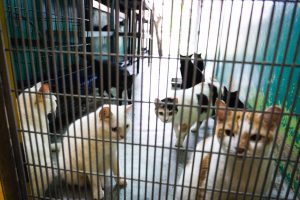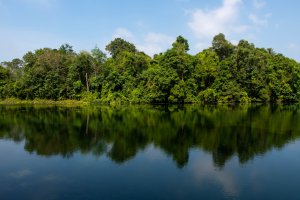All photography by Feline Lim for Rice Media
I have never liked durians. My parents told me that I used to eat it excessively as a toddler, but I eventually got sick of it and, well, the rest is history. This is why I cannot understand the fuss over durians. What is up with the long queues for the king of fruits and territorial disputes over its trees?
Especially the latter, where it’s against the law to pick or harvest fruits from the forests. Why would people risk getting caught just to savour the yellow creamy flesh?
This calls for some serious debunking. And since I’m a serious journalist, and we’re still in the thick of durian season, I decided to tag along with 55-year-old Tony (not his real name) who works in sales and marketing, as he treks into the woods to gather some of these green thorny fruits.
With friends around me having durian feasts into the odd hours of the night, the least I could do is to learn more about the allure of the fruit, if only to appear more invested and contribute to the conversation. Because I’m what? A journalist and I’m sickening *cues Laganja Estranja theatrics*.
A crash course on durians
To be honest, I’m dreading this early dawn adventure into the forest. We’re meeting at 6.30 AM when most of Singapore is still in slumberland. Why am I torturing myself to learn about a fruit that I don’t even like?
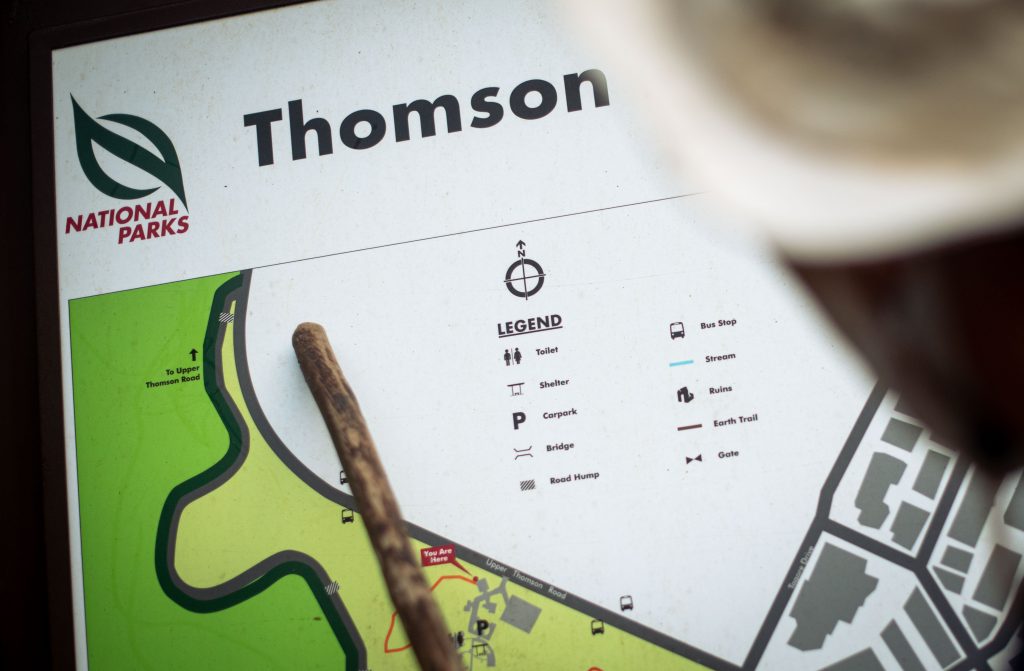
Anyway, here we are—me and my colleague Feline, both of us bleary-eyed at Thomson Nature Park with Uncle Tony, who lugs along an army field pack, and dons grey-coloured trekking pants and combat boots for the adventure.
He’s a seasoned durian picker as evident by the tools of his trade: a small knife and gloves (to pry open the thorny fruit), an emergency whistle and torchlight (to attract attention if one is lost), insect repellent, a first aid kit, a comb (to brush dirt off the durian husk), and a gunny sack (to contain the durians).

Uncle Tony’s durian journey started in 2006 when he saw durian pickers in the Woodlands vicinity where he lives. They were lugging their sack loot of durians and he bought some. Soon after, he joined the club.
“You all got buy insurance or not? We are entering the jungle,” Uncle Tony mentally prepares us.
He tells me this year is considered a healthy harvest for durians—the durian season normally lasts from June to early October. This is why there are more people than usual scavenging for durians now, although getting stuck in Singapore due to the pandemic is also another possible reason.
Strangely, he says, the durian harvests in the last two years were poorer. “Maybe the trees wanted to rest due to Covid-19 too,” he quips.
As I’m a noob with durians, he gives me a quick run-down on the fruit: the trees start to flower in early March and the fruits emerge about 120 days later. According to the National Parks Board (NParks), the species commonly found in Singapore are the Durio zibethinus, Durio singaporensis, and Durio griffithii.
Uncle Tony adds that thanks to pollination by insects, only 10 to 20 per cent of the flowers bloom into fruits; of which, only about half of them grow into big durian fruits.
In other words, it’s not easy to harvest good durians. You only get your pick from those that have fallen off from trees and still remain intact, uneaten by wild animals.
Entering the forest
Uncle Tony leads us deeper into the nature reserve, where the durian trees can be found. He says the trees, which are at least three decades old, were left behind by villagers when they vacated the area in the 1980s. Chinese settlers used to live in the area and they planted durian trees so they could sell the fruits to supplement their incomes.
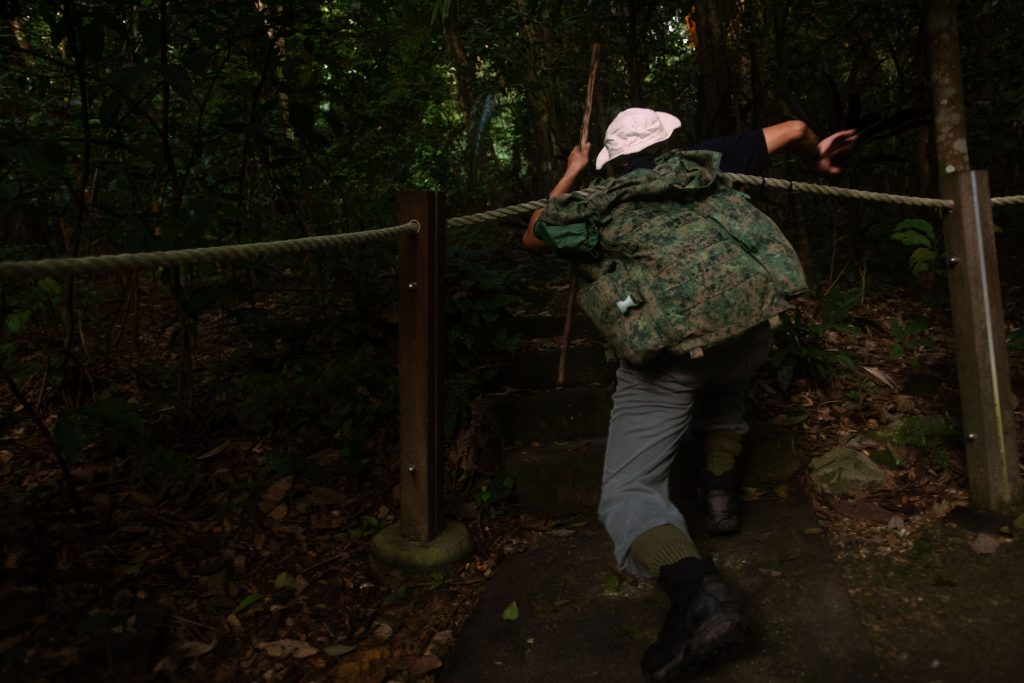
As a city dweller, I’m not used to trodding on undesignated paths, which are filled with uncertainties. Every step I take is filled with unease.
Will there be holes on the forest floor which I can accidentally trip and fall in? What if the dangling sharp branches from the trees hook onto my shirt and rip it apart?
Uncle Tony is probably silently judging Feline and I, who are clearly amateurs at this, as he bashes through the thick vegetation effortlessly. I can read his mind: You young people are weak … SMH.
It’s a rough trek into the secondary forest. I would rather walk on the sturdy cemented paths paved by the good folks of NParks. Perhaps NParks could even consider adding on a covered pathway while we are at it, since we are a “sheltered walkway nation”.
But for the sake of finding the green thorny fruit, I will soldier on.
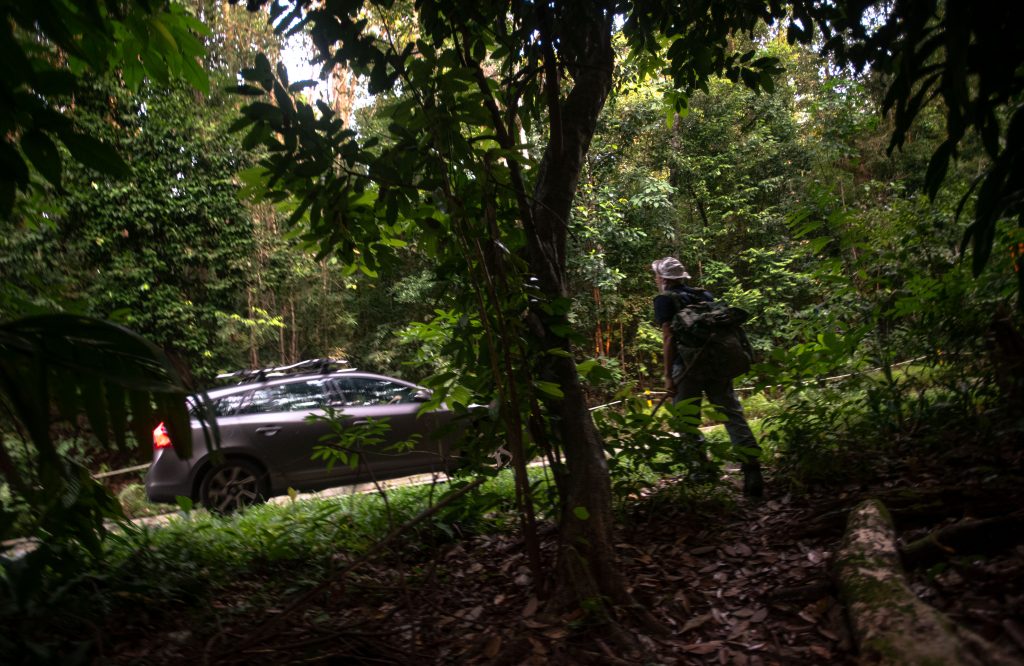
According to Uncle Tony, durian pickers go off-track because trees grown in the gently-sloped areas produce better durians, unlike those that are grown near the streams. Durians don’t grow well in waterlogged soil.
This is also why Uncle Tony says the quality of durians this year has deteriorated, as the monsoon season was delayed and coincided with the durian season. For durians to have the highest sugar concentration, the weather has to be hot and dry during the harvesting period. Wet conditions will result in durian flesh that is less yellow and more bland.
Getting the coveted fruit—finally
It has been more than an hour into our treacherous hike in the forest. The thick layer of insect repellent we sprayed doesn’t deter the commando-trained mosquitoes from biting us.
Feline, who is unfortunately wearing a black sleeveless top , has visible puffy and red bumps on her arm. Ditto for me too, even though I am wearing a shirt with sleeves. Although Uncle Tony is a “regular” here, he is not spared either, as he shows us an insect bite on his neck.

At 8.32 AM, we spot the first signs of the coveted fruit on the forest floor. There are more durians along the way but they are either rotting or already pried open by the monkeys.
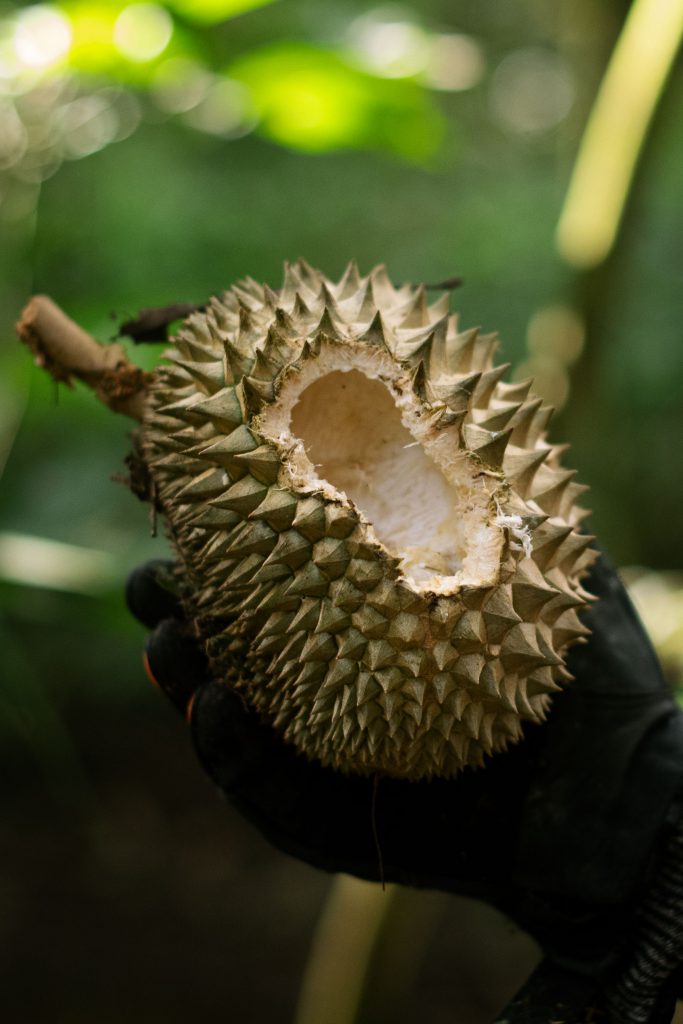
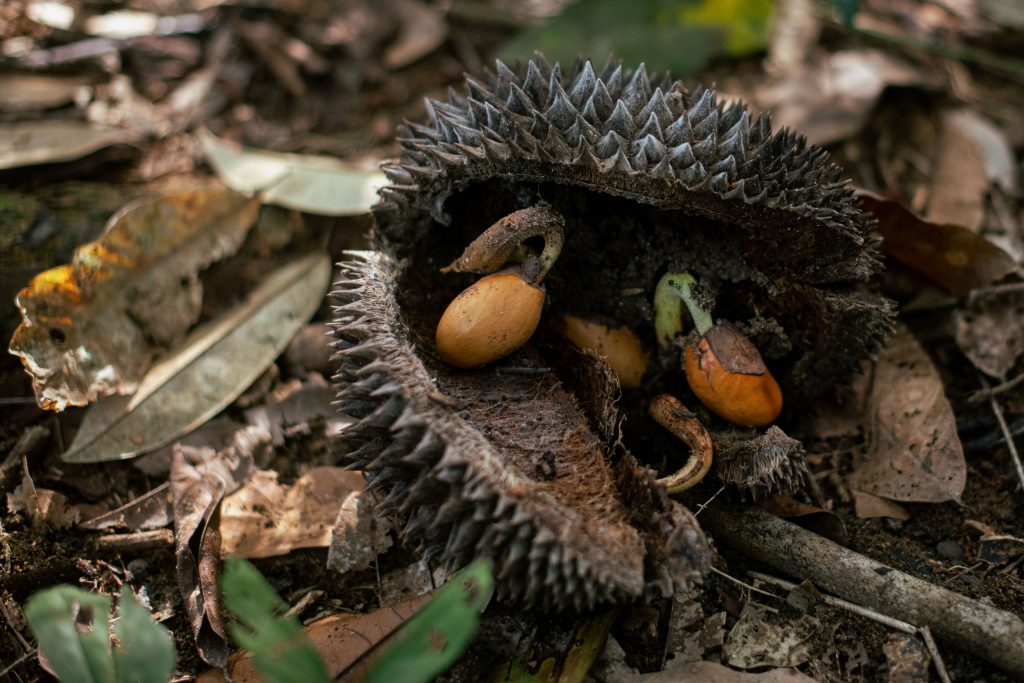
No durian picker worth his or her salt will shake a durian tree for the fruit to fall, or pluck one that is hanging. According to Uncle Tony, durians that fall naturally taste better.

As we are at the tail end of this season, most of the fruits are already harvested by other durian fans. This is why it takes us longer than usual to find a good, fallen durian.
On a good day, Uncle Tony says, he can pick up to 20 to 30 shells of the thorny fruit. He usually spends two to three hours in the forest alone and claims that the shortest time he ever spent was 15 minutes. Not once did he return home empty-handed, he says.
Opening the fruit
Using the knife and gloves Uncle Tony brought, he pries open the first fruit we collected. It fulfils the conditions of a good durian: a stem end that’s still moist and light in colour, a distinctive aroma, and one that hasn’t been tampered with by animals.
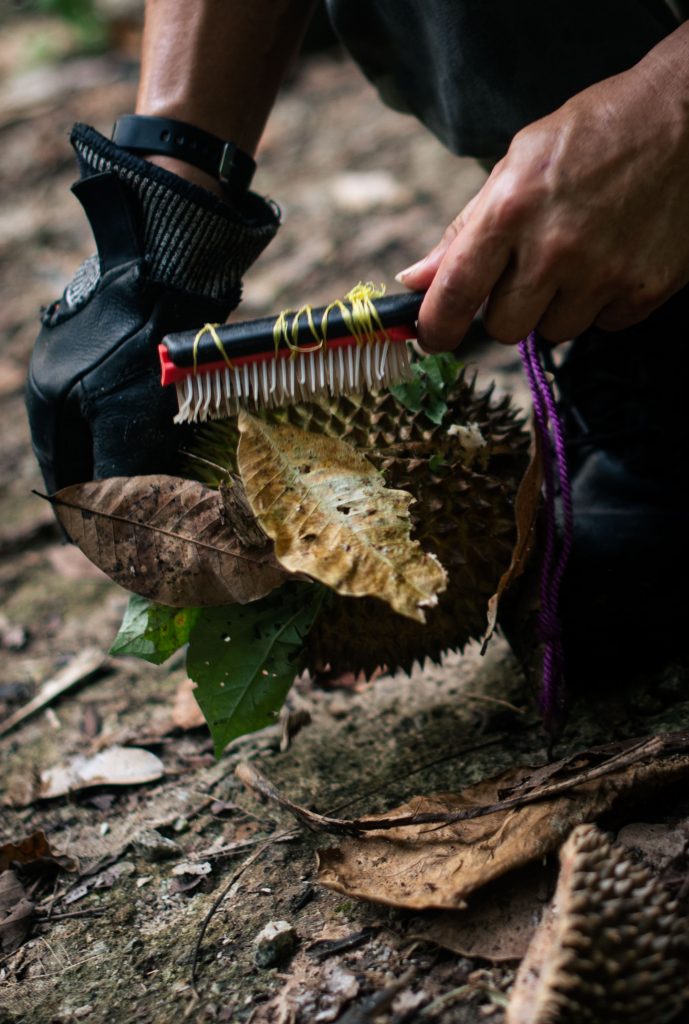


Alas, as we crack it open, we found the fruit infested with ants. Some of the flesh remains mushy and doesn’t look appetising. Nevertheless, Uncle Tony continues to slice the durian open into its different pods.
“Sometimes I’ll just open it up for the wild boars and monkeys to eat,” he says.

Our luck improved with the second fruit. With some twists and turns of the blade, Uncle Tony cranks open the durian. The small, yellow, custard-like nuggets are nestled perfectly and undisturbed in their pods. Feline and I, like the modern city-dwellers that we are, whose durians come from NTUC, wowed in delight.

Uncle Tony, however, doesn’t seem impressed. “This one… not as ripe, lah. Half-past six.” His reservations aside, we can’t resist but have a taste of the fruit.
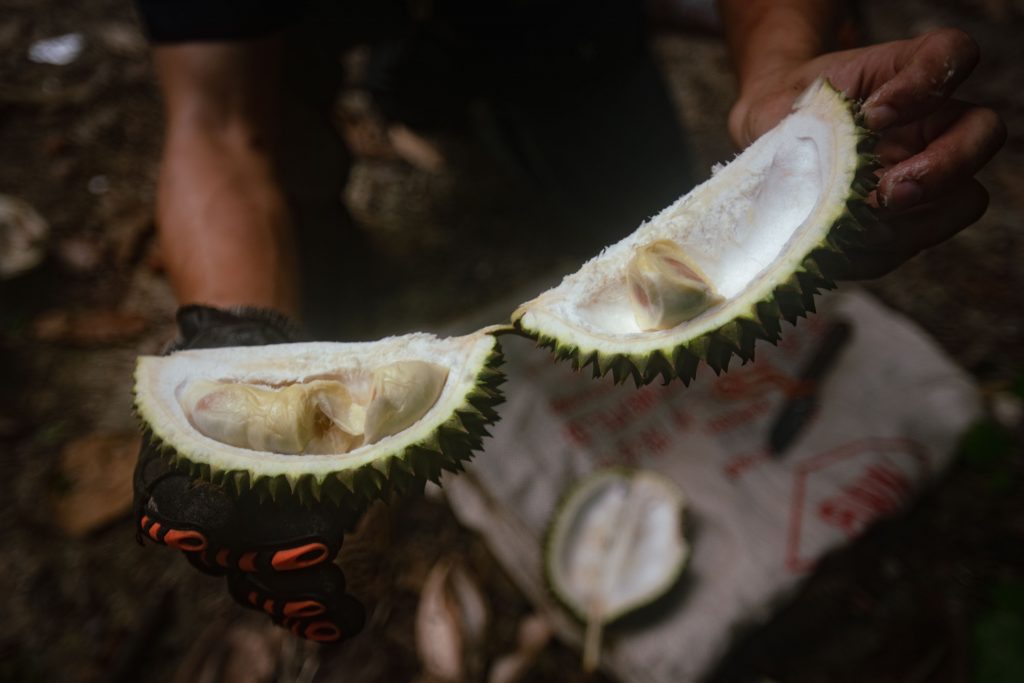
Yes, including me. I hate the fruit but what are the chances to have a taste of wild durians? I recall durians having an overpowering taste when I was forced to eat it some years ago. Surprisingly, this isn’t the case for the fruit we just picked. It is quite light and mild in taste.
Uncle Tony says these fruits not only taste better, but they also do not contain chemicals that can have long-term adverse health effects.
The bulk of our durians come from plantations of neighbouring countries, some of which use ripening agents such as Ethephon to ripen them artificially to meet demand.
Despite these benefits, I remain a durian cynic, kampung or otherwise. After nibbling the flesh, I cringe, which amuses both Uncle Tony and Feline, and I immediately gulp down water to wash off the nasty aftertaste.
Uncle Tony is well-prepared. He has brought with him a plastic container to collect the durian flesh, so he doesn’t need to lug along the heavy husks of the durians. Not everything is for himself, though. He believes in sharing good things with his neighbours.

After emptying the fruit of its contents, he chucks the shells aside for them to decompose naturally.
The inhabitants of the forest
We trek for another two hours, in search of more durians. But it’s a fruitless attempt *inserts “ba dum tss” sound effect*. As we walk towards the endpoint, the sight of a mini living settlement in the middle of the forest catches our attention.
A collapsed tentage can be seen, together with makeshift tables and reclining chairs. Upon some scavenging, we also see necessities stored in a transparent box, such as instant coffee packets, clothing, and a portable stove.
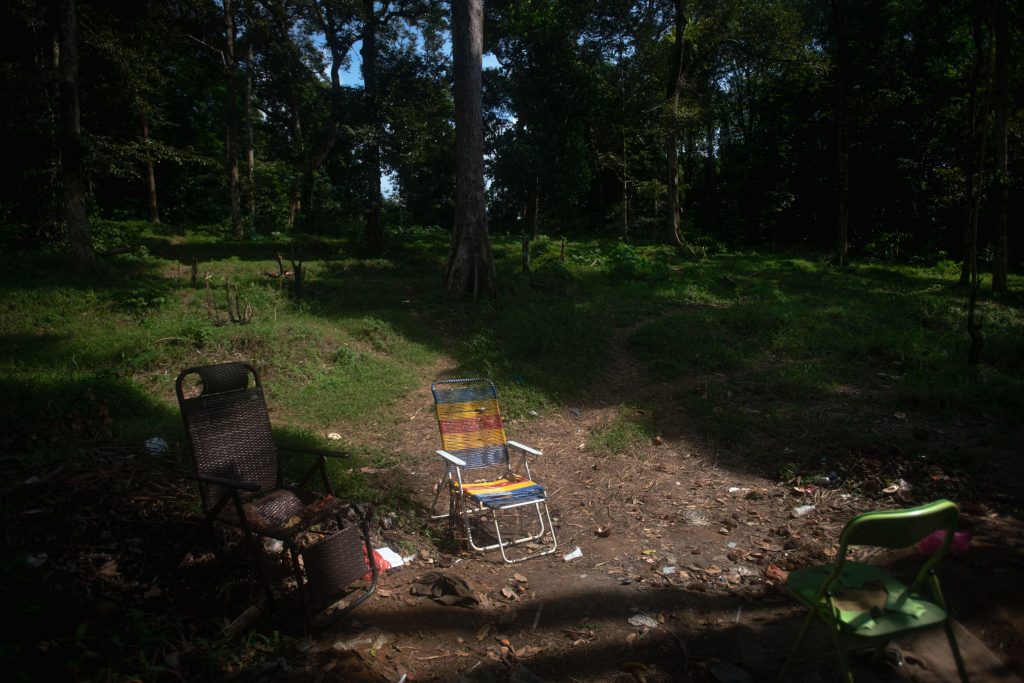
What’s disconcerting is the trash strewn around—empty beer cans, blackened and rotten durian husks, cigarette butts and egg carton boxes which, when burnt, emit a light smoke to repel mosquitoes.
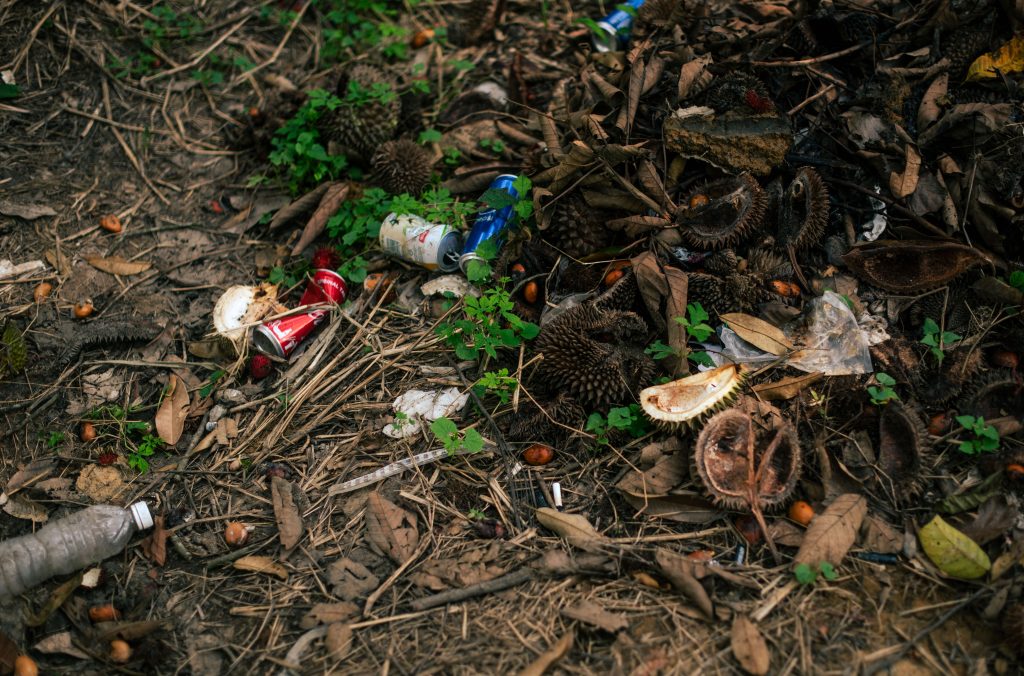
Uncle Tony says the furniture was assembled by seasonal durian pickers who came by during the peak of the season, as a resting point after collecting their prized fruits. These people are not around today because there’s nothing much left to gather from the forest.
Besides local durian pickers, Uncle Tony shares that there are also migrant workers who, after ending work, enter the forest at night to collect durians for their own consumption.
He says most of them may not be able to afford premium durians sold in the shops. These organic durians are a way for them to enjoy the fruit without incurring costs.
“It’s quite sad, honestly, to see durian scavengers leaving litter behind. They bring a bad name to us. When I see them, I remind them to clear up and keep the area clean,” says Uncle Tony.
“The authorities have somewhat turned a blind eye to durian-picking activities so we shouldn’t be creating unnecessary attention, be it through inconsiderate behaviour or territorial disputes.”
Uncle Tony refers to the recent police case, where 11 people were arrested—10 men and a woman, aged between 25 and 59—for allegedly trespassing a protected area along Mandai Road to pick durians. The police were alerted because a fight took place.
Under the Parks and Trees Act, those who pluck or collect fruit in a public park without permission can be fined up to $5,000. If the same is done at a nature reserve, a person can be fined up to $50,000 and or be jailed for up to six months.
NParks says the fruits are a source of food for native animals in the forest, and collecting or plucking them will deprive them of dietary resources.

Uncle Tony hopes the rules can be relaxed. It doesn’t make sense when the law states that it’s illegal to collect fruits which have fallen on the ground, he says.
“But if they are not consumed by animals, they will eventually rot and it’s a waste. The authorities should strike a balance between animal welfare and such outdoor pursuits.”
Perhaps NParks can take inspiration from a similar initiative by Tampines Town Council. During the mango season, the town council would harvest the fruits from trees within the neighbourhood and distribute them to residents for free. All these are done sustainably.
It would be great if the same initiative could be enacted for durian. NParks can recruit these durian pickers as volunteers or pay them a nominal amount to collect the durians in a supervised manner. The durians can then be served at a community durian fiesta (of course, only when the Covid-19 situation improves).
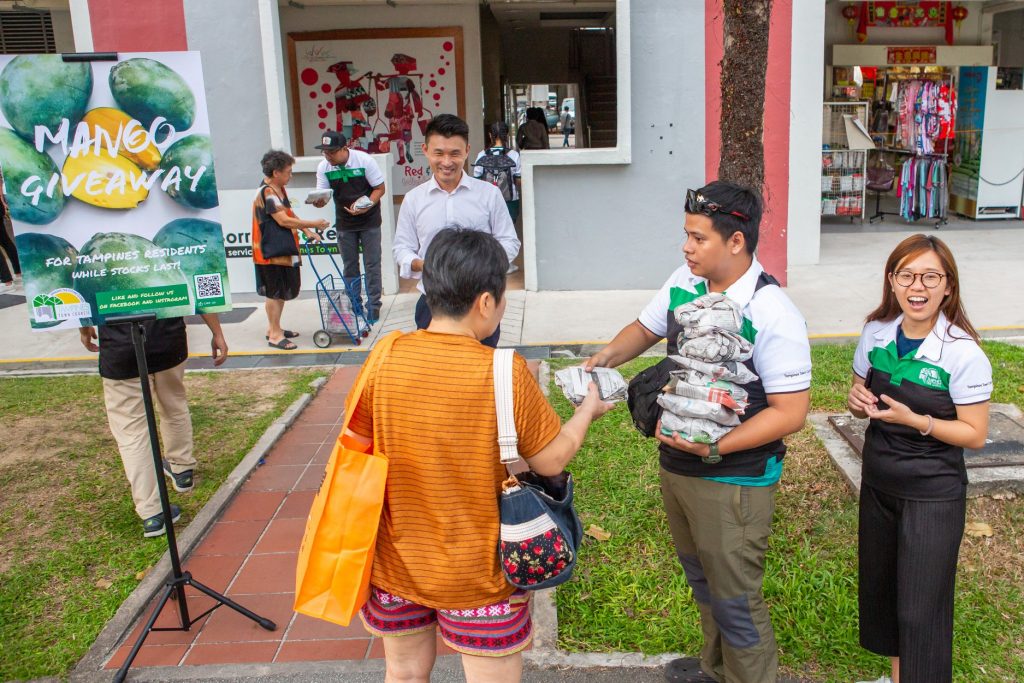
Many birds can be killed with one stone here: Not only can durian-picking be managed, but the durian-picking heritage will be preserved too (a concern shared by a picker in The Straits Times).
If my suggestion comes to fruition, I wouldn’t mind joining in a mini-expedition to pick durians. It’s a good exercise actually, judging from the amount of legwork we have done and the sight of our sweat-drenched shirts. Needless to say, I would also love to attend those community durian parties and get to know more people who live around me.
But just one request: can other fruits be served as well, besides durians? Pretty please?
Are you one of those who pick durians in the parks too? Tell us at community@ricemedia.co.
If you haven’t already, follow RICE on Instagram, Spotify, Facebook, and Telegram. If you have a lead for a story, feedback on our work, or just want to say hi, you can also email us at community@ricemedia.co.




